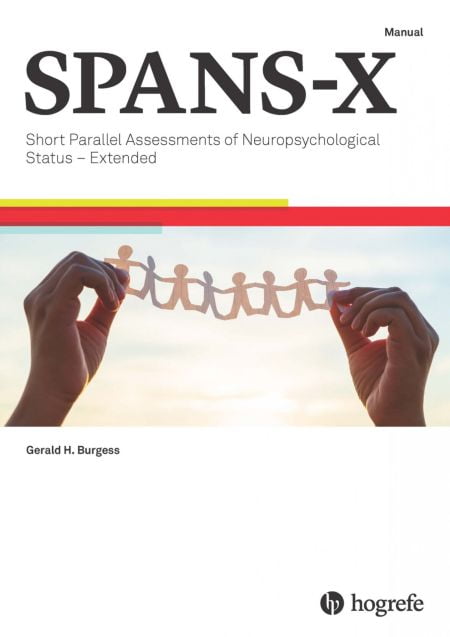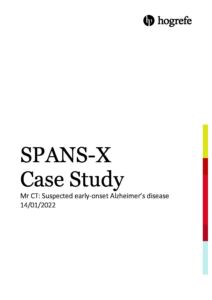
Short Parallel Assessments of Neuropsychological Status - Extended spans-x
Author: Dr Gerald H. Burgess
Serves as: Battery of neuropsychological tests for accurate cognitive measurement
Age: 18 - 90 years
Format: Paper and Pencil
Scoring: Hand-scored
Time: 30 minutes to administer
Printed Manuals
Physical printed manuals.
Printed Forms & Handscoring Materials
Test forms, response booklets and scoring reference manuals.
SPANS-X Manual
SPANS-X Scoring Booklet Version A (pack of 25)
SPANS-X Scoring Booklet Version B (pack of 25)
Sample Reports
Overview
The Short Parallel Assessments of Neuropsychological Status – Extended (SPANS-X) is a battery of neuropsychological tests for accurate cognitive measurement. This new extended version allows for reliable remote administration and features extended norms spanning 18 to 90 years, as well as individual percentiles and critical cut-off scores for each age. The ‘X’ in ‘SPANS-X’ stands for extended, extra and exceptional utility; it’s a bigger, bolder, and more precise assessment of acquired brain injury, dementia, and other neurological and neuropsychological disorders.
Product Description
Developed directly from clinical experience and an up-to-date review of the literature, the SPANS-X is a brief, yet comprehensive battery that reliably measures seven cognitive, perceptual, and language skills. Sensitive and specific, the assessment determines the presence of deficit accurately and easily, whilst the engaging and ‘culture fair’ materials make the test enjoyable for all, including those who may have attentional challenges.
The SPANS-X produces seven reliable index scores across 30 subtests, plus a Total Score:
Orientation
Attention/Concentration
Language
Memory/Learning
Visuo-Motor Performance
Efficiency
Cognitive Flexibility
Features
Now with a norm for every age from 18 to 90 years, calculated using an innovative nonlinear regression process, for precise and accurate interpretation
Can also be reliably administered remotely via videoconference or in-person
Includes equivalent alternate versions for reliable retest while minimising practice effects
Focuses on ‘functional’ everyday skills for real-world application
Features simpler administration and new streamlined scoring for quick and accurate results
Includes expanded interpretation guidance – including specific guidance for using the measure in different situations (such as assessing mental capacity, testing those with intellectual disability or with yes/no only responding, etc.)
Now with new validation studies and updated reliability studies
The SPANS-X will be of benefit to clinical psychologists working in acute brain injury, older adult memory clinics, health or medical settings, forensic settings, or in the areas of alcohol and drug abuse. Now with extended norms (18 to 90 years), the measure will be particularly valuable to psychologists working with older adults, as well as counselling, forensic, and health psychologists, neuropsychologists, neurological occupational therapists and speech and language therapists working with adults of all ages.
How the SPANS-X compares to other tests of neuropsychological status
The updated and extended SPANS-X offers various features differentiating it from other tests of brain injury, dementia and general neuropsychological status. These include:
A norm per age, from 18 to 90 years, calculated using an innovative polynomial regression process
More and briefer subtests overall, and more subtests per index score – making more internally reliable index scores and a more engaging test
More recent norms for more accurate interpretations
The option to be used remotely via video call with a test taker, as well as face to face – other cognitive tests have not been adapted in this way (the advice given is to just not use a particular test/task), whereas the e-SPANS-X has been validated against the regular SPANS-X
Better alternate-version test-retest reliability across all index scores
The SPANS-X is sensitive and specific to cognitive impairments and provides a wider variety of observations, including screening for neurological conditions that the main competing product does not
The SPANS-X can be used by Neuropsychologists, Clinical, Health and Forensic Psychologists, Occupational Therapists, Speech and Language Therapists, and other medical professionals .
We recommend all users familiarise themselves with SPANS-X, even if they have previous experience in using SPANS and we will be happy to advise current SPANS users. In addition to providing clinical case studies and the evidence base for SPANS-X, PAA with cooperation with Hogrefe can help test users should they have any queries regarding the administration, scoring and interpretation of results. Please contact us.
Reliability
Internal consistency and unique variance of SPANS-X index and total scores (.72–.94).
Alternate version equivalency, test-retest reliability (.96) and excellent inter-rater reliability.
Test Validity
Convergent and divergent validity:
WAIS Verbal IQ (.08–.66); WAIS Performance IQ (.23–.70); WMS (.34–.71); Rey (-.37–.69); Trail Making Test (-.18 – -.90)
ABI and healthy groups; SPANS sensitivity to lateralised damage
Validation studies include: the use of SPANS-X as a screening measure for the detection of dementia in adults aged 75 and above, the use of SPANS-X with people with mild-to-moderate intellectual disability, the effects of English as a second language on SPANS-X performance.
Norms
The SPANS- X now provides unsurpassed accuracy compared to other short battery neuropsychological tests – with this latest version including the following norm enhancements:
Updated norm sample with a norm for every age and an extended age range now spanning 18 to 90 years (index scores)
New metrics used, including percentiles, confidence intervals, base rates, and critical values, plus new, easier to use norms tables
The Manual includes details of the norm calculation process and guidance on how to use the norms to interpret the results




